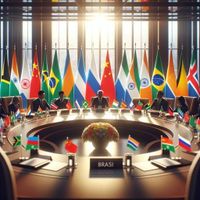When world leaders gather, it’s often a sign that something big is brewing on the international stage. This week, all eyes are on BRICS—a group that, over less than two decades, has rapidly transformed from an acronym for emerging economies into a powerful global bloc. Now, the group is poised for another leap, as Laos signals its interest in joining, and member nations prepare for a virtual summit aimed at tackling some of the world’s thorniest trade issues.
On September 5, 2025, Lao Prime Minister Sonexay Siphandone made headlines at the 10th Eastern Economic Forum (EEF) by announcing his country’s growing interest in joining BRICS. Speaking at the plenary session, Siphandone emphasized, “We are interested in becoming a BRICS member. And we are currently in the process of studying this issue.” His remarks, reported by Vietnam News Agency and corroborated by Bernama-Sputnik/RIA Novosti, signal a new chapter in Laos’s foreign policy and economic ambitions.
The timing of Siphandone’s statement is no coincidence. The EEF, held in Vladivostok from September 3 to 6, brings together policymakers and business leaders from across Eurasia. For Laos, a landlocked Southeast Asian nation with a fast-growing but still developing economy, the opportunity to join a group like BRICS—now comprising Brazil, Russia, India, China, South Africa, Egypt, Ethiopia, Iran, Indonesia, and the United Arab Emirates—could open doors to new partnerships and a broader global role.
“BRICS countries are showing significant results in economic growth and influence on global economic development,” Siphandone noted, highlighting the bloc’s growing clout. Indeed, since its creation in 2006, BRICS has expanded both its membership and its ambitions. On January 1, 2025, Malaysia, Belarus, Bolivia, Kazakhstan, Thailand, Cuba, Uganda, Nigeria, Uzbekistan, and Vietnam joined as partner countries—a sign of the group’s widening appeal.
But why is BRICS suddenly so attractive? The answer lies in its ability to offer an alternative to the traditional Western-led global order. As Siphandone put it, frameworks like BRICS “enable parties to find solutions to modern challenges.” For many countries, especially those outside the G7, BRICS represents a forum where their voices can be heard, and their interests better represented.
This week, BRICS is taking on another urgent challenge: trade tensions that have simmered since the United States, under former President Donald Trump, imposed sweeping tariffs on a range of goods. These measures, aimed at protecting American industries, sent shockwaves through global supply chains and left many countries scrambling to adjust. Now, BRICS is gearing up for a virtual summit—scheduled for the week of September 6, 2025—under Brazil’s presidency, with the goal of forging a united response.
India’s External Affairs Minister S Jaishankar will participate in the summit, which will be led by Brazilian President Luiz Inacio Lula da Silva. According to Devdiscourse, the meeting’s primary focus is to address “trade disruptions following the United States’ stringent tariff policies.” Lula, a veteran of international diplomacy, hopes to steer the group toward a common strategy that can help its members weather the economic storm.
BRICS’s weight in the global economy is hard to overstate. Collectively, its members account for a substantial share of the world’s population and economic output. As the group’s influence has grown, so too has its ability to shape the rules of international commerce. The upcoming summit, therefore, is not just a routine gathering—it’s a high-stakes effort to recalibrate global trade relations in the face of protectionist headwinds.
The summit’s agenda reflects the concerns of many developing nations, who have long argued that the existing global trade system favors the wealthy and powerful. By forging a unified approach, BRICS hopes to amplify its collective bargaining power, both in negotiations with the United States and within institutions like the World Trade Organization.
“Such cooperation frameworks enable parties to find solutions to modern challenges,” Siphandone reiterated at the EEF, a sentiment that resonates with many countries seeking a more balanced and inclusive global order. For Laos, joining BRICS could mean greater access to investment, technology, and trade opportunities—benefits that are especially appealing as the country looks to accelerate its economic development.
Of course, the path to membership is not automatic. As Siphandone acknowledged, Laos is “currently in the process of studying this issue.” The decision will require careful consideration of both the opportunities and potential risks. Membership in BRICS, while prestigious, also comes with responsibilities and expectations—especially as the group takes on a more prominent role in global affairs.
The expansion of BRICS has not gone unnoticed by the rest of the world. As more countries express interest in joining—either as full members or as partners—the group’s ability to coordinate and act as a unified bloc will be tested. Can BRICS maintain cohesion as its ranks swell? Will it be able to deliver tangible benefits to its members, especially the newer and smaller ones?
For now, the mood among BRICS nations is one of cautious optimism. The inclusion of new partners like Malaysia, Belarus, and Vietnam earlier this year has injected fresh energy into the group. At the same time, the challenges posed by global trade tensions and shifting economic alliances have underscored the need for collective action.
As the virtual summit approaches, expectations are high. According to Devdiscourse, the “unfolding discussions may significantly impact the trajectory of international trade relations.” If BRICS can present a united front and articulate a clear vision for the future, it could reshape the global economic landscape—making it more multipolar and, perhaps, more equitable.
For Laos, the journey toward BRICS membership is just beginning. But the country’s willingness to engage with “open mechanisms” and seek new forms of cooperation signals a broader trend: the rise of new voices and new alliances in a world that’s no longer dominated by a handful of powers. As Siphandone’s remarks in Vladivostok make clear, the search for solutions to modern challenges is a shared endeavor—one that requires both ambition and collaboration.
In the coming weeks, the world will be watching to see how BRICS responds to the latest round of trade tensions, and whether the group’s expanding membership can translate into real influence. For now, one thing is certain: the center of gravity in global affairs is shifting, and BRICS is determined to play a leading role in whatever comes next.




